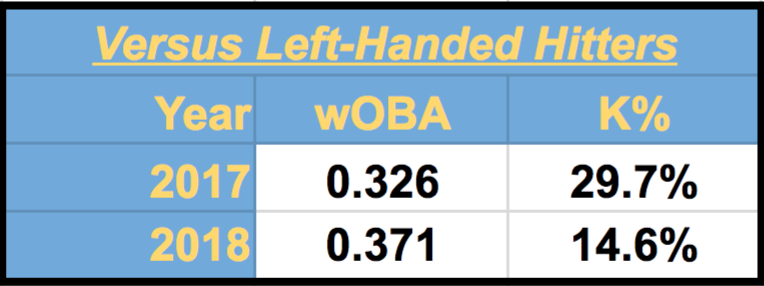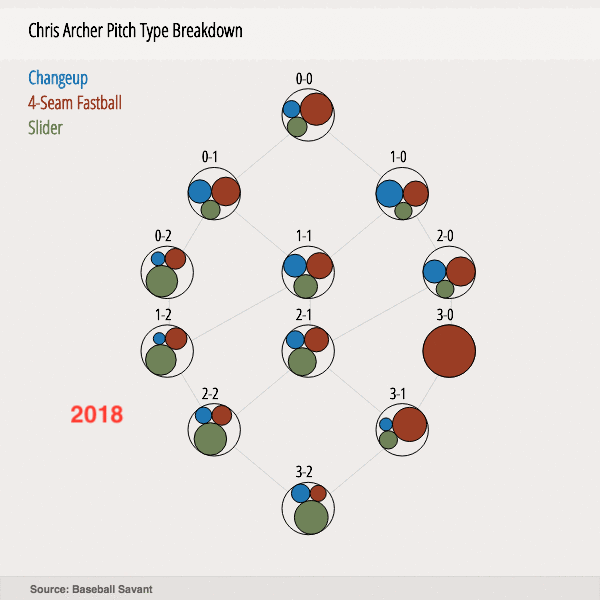The answer to this question would ease the minds of owners all across the fantasy universe [insert Avengers joke here]. Chris Archer hasn’t performed well enough to warrant selection in the same stratosphere as his preseason ADP. His strikeout rate is down, walks are up, and he’s getting hit harder than he ever has. This has created the notion that the Rays’ ace is declining, simply because he is approaching the age of 30 with numbers that don’t represent his past performance.
Assuming any given player follows a smoothed performance curve through their careers is incorrect. Curves representing how players age are the compilation of aggregate data points suggesting the average peak is right around 27 years old. Players can peak before or after that mark and the trend line can still retain its shape.
A mental exercise to perform is considering whether you believe general aging curves do in fact hold value. If your answer is yes – which it should be – then consider whether Archer has declined at an unexpected rate; more than a general aging curve would have suggested. Based on projections, the answer to this question should also be yes, even if you were the “low man” on Archer coming into the season.
This leaves three possibilities: further decline, stabilization, or improvement. Option number three is where most should guess Archer ends up, especially if you think he has declined more than expected through 11 starts. Thankfully, this is the logic I follow as well. How much room there if for improvement in Archer’s game is the big question.

Above is a simple look at Archer’s year-over-year splits against the handedness of hitter with a natural advantage versus his heavy fastball-slider combination. Archer’s effectiveness versus right-handed hitters remains stable when comparing 2017 to 2018, making the culprit behind this discrepancy in lefty effectiveness a good starting point. With the baseline knowledge that Archer mixes in his changeup only to left-handed hitters, my initial thought was this offering may have changed compared to last year. This brings us to a bit of a rabbit hole.
Just over a month ago, Rays Manager Kevin Cash said he didn’t agree with the concept that Archer needed to throw his changeup more to left-handed hitters. This theme has been commonly discussed with Archer for an extended period of time, with outlets pondering how Archer could be an ace if he didn’t have an effective third pitch (example one, example two).
So what happened? Archer started throwing his changeup more – contrary to Cash’s belief that Archer didn’t need to – increasing the pitch’s usage six percent to left-handed hitters from 2017 to 2018.
How Archer was using the pitch changed slightly as well. Keep an eye on all of the two-strike counts in the bottom left of the GIF below. The blue dot represents Archer’s changeup usage.

*Count breakdown versus left-handed hitters
In 2018, Archer has been turning to his changeup more, and turning to it in two-strike counts, providing some context that Archer has become more confident in the pitch itself.
We’re not only looking at more changeup usage and different changeup usage, but we’re actually looking at a slightly altered pitch as well, which brings us back to aging curves. Presented below is a pitcher-specific aging curve for particular stats, showing the deviation away from a player’s average after their age 27 season.

Velocity decrease is the most visually striking in the plot above, and most applicable given how important a component it is to changeup effectiveness. Many anthologies exist breaking down the relationship between velocity differentials of fastball-changeup combinations (like this one), with the resounding point suggesting that a 7-10 mph difference between the two pitches is ideal. A larger differential (closer to 10 mph), generally results in more whiffs, while a small differential (7 mph), generally leads to more groundballs.
This effect is represented well when examining Archer’s fastball-changeup relationship from 2017 to 2018. Abiding by the aging curve, Archer has lost roughly .4 mph on his fastball (depending on your site of choice, mine is Baseball Savant), but gained just over 2 mph of velocity on his changeup. This has changed his fastball-changeup differential from 9.8 mph in 2017 to 7.2 mph. To confirm the world is indeed round – sorry, Kyrie – Archer’s changeup has become slightly more of a ground-ball pitch, with his groundball to fly ball ratio on his changeup rising from 3.4 in 2017 to 5.0 so far in 2018.
While this gives some context to the drop in whiffs versus left-handed hitters, it fails to explain why the overall performance of Archer has been so poor.
If his changeup is merely different and not less effective, then the issue must be embedded within either his fastball or slider. Fangraphs contests the issue is within both, grading each out as average to below average pitches this year based purely on results, both with a noticeable decrease from 2017 (per Fangraphs pitch values/100).
Yet the difference for each of Archer’s fastball and slider are more subtle than worrisome. His fastball location to left-handed hitters is slightly elevated this year, bordering on out of the zone, which could be a reason for the pitch’s drop in whiff rate (down 6 percent from 2017 to 2018). While the pitch’s slight drop in velocity helps validate proper aging for Archer, as we noted above, the bigger differential was in Archer’s changeup velocity. Archer’s fastball velocity is still above the 90th percentile in the league.
His slider has become a slightly flatter pitch too, with Baseball Prospectus’ Pitch F/X leaderboard showing the pitch has more horizontal movement than it had in the past and less vertical drop on average. This could be Archer manipulating the pitch in an altered way, but with a stable whiff per swing rate from 2017 to 2018, its effectiveness remains largely in tact.
Is there any merit to the substance of a pitch remaining stable, but the result deteriorating? Is there any chance that Archer using his improved changeup more to left-handed hitters has hurt his slider’s effectiveness? This seems to be a weird way to cite why Archer’s slider is getting beat up by left-handed hitters, but it’s a hypothesis nonetheless.
- 2018 AVG/SLG versus Archer’s slider (LHH)
- .296/.568
- 2017 AVG/SLG versus Archer’s slider (LHH)
- .214/.332
Archer, with an improved changeup, has actually become less effective with the pitch that has carried him through the better part of four seasons. Whether the two are tied together, or merely coincidences, might be the key to understanding whether improvement from his hard decline is in store.
The Player Rater believes Archer is still a top-15 starting pitcher, with a strong finish in store; one that resembles the years where his changeup was more of an afterthought and his slider reigned supreme. Archer may be declining, but the substance of his repertoire is still in tact, which provides optimism 2018 can still be turned around.
On Twitter, I do not decline – @LanceBrozdow
Podcast #1 – Ralph and I talk prospects – Razzball Prospect Podcast (Archive)
Podcast #2 – I talk about pitchers – TwoStrikeApproach (Spotify, Apple Podcasts)


